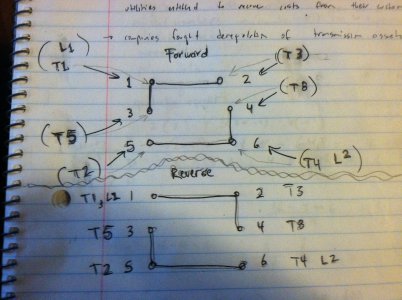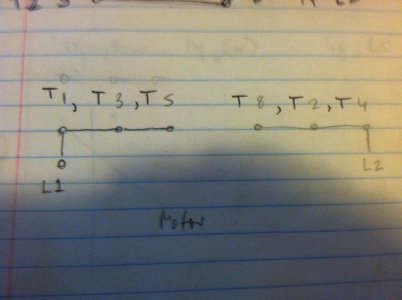so, long story short, i got a free 12x24 inch chinese lathe from a fellow in long island. in good functional shape but motor is fried / seized, and
original electrical configuration was so damned complicated that after having disassembled to carry it into my basement shop, i am not even
gonna try to get it back together again.
instead i am using a rockwell motor i had sitting around (an old america 1 hp single phase motor) and wiring a drum switch. was the best i could do with
my budget of basically nothing for the time being. had local motor shop test the motor, seems to work fine.
i have the "L shaped" type drum switch. its a dayton.
the motor has six wires labeled t1, t3, t5 and t8 t2 t4.
i show what terminals i will connect them to on the drum switch in the first drawing.
L1 and L2 are obviously the hot and neutral from the panel.
this is to be set up for 110 v. the second drawing is a clearer drawing of the wiring configuration
of the motor for 110 v.
also a little unsure how to ground properly? i will be using bx shielded wire,
and i think on my old south bend they seemed to have used the bx shielding to connect ground to
the motor casing / lathe? doesnt seem like the motor really has a proper ground
wire unless i am missing something? my electrical panel is grounded, and it will be hard wired
to a junction box on the ceiling of the basement where it is located.


also pictures here:
https://picasaweb.google.com/100633410173082846352/20130601?authuser=0&feat=directlink


original electrical configuration was so damned complicated that after having disassembled to carry it into my basement shop, i am not even
gonna try to get it back together again.
instead i am using a rockwell motor i had sitting around (an old america 1 hp single phase motor) and wiring a drum switch. was the best i could do with
my budget of basically nothing for the time being. had local motor shop test the motor, seems to work fine.
i have the "L shaped" type drum switch. its a dayton.
the motor has six wires labeled t1, t3, t5 and t8 t2 t4.
i show what terminals i will connect them to on the drum switch in the first drawing.
L1 and L2 are obviously the hot and neutral from the panel.
this is to be set up for 110 v. the second drawing is a clearer drawing of the wiring configuration
of the motor for 110 v.
also a little unsure how to ground properly? i will be using bx shielded wire,
and i think on my old south bend they seemed to have used the bx shielding to connect ground to
the motor casing / lathe? doesnt seem like the motor really has a proper ground
wire unless i am missing something? my electrical panel is grounded, and it will be hard wired
to a junction box on the ceiling of the basement where it is located.


also pictures here:
https://picasaweb.google.com/100633410173082846352/20130601?authuser=0&feat=directlink



